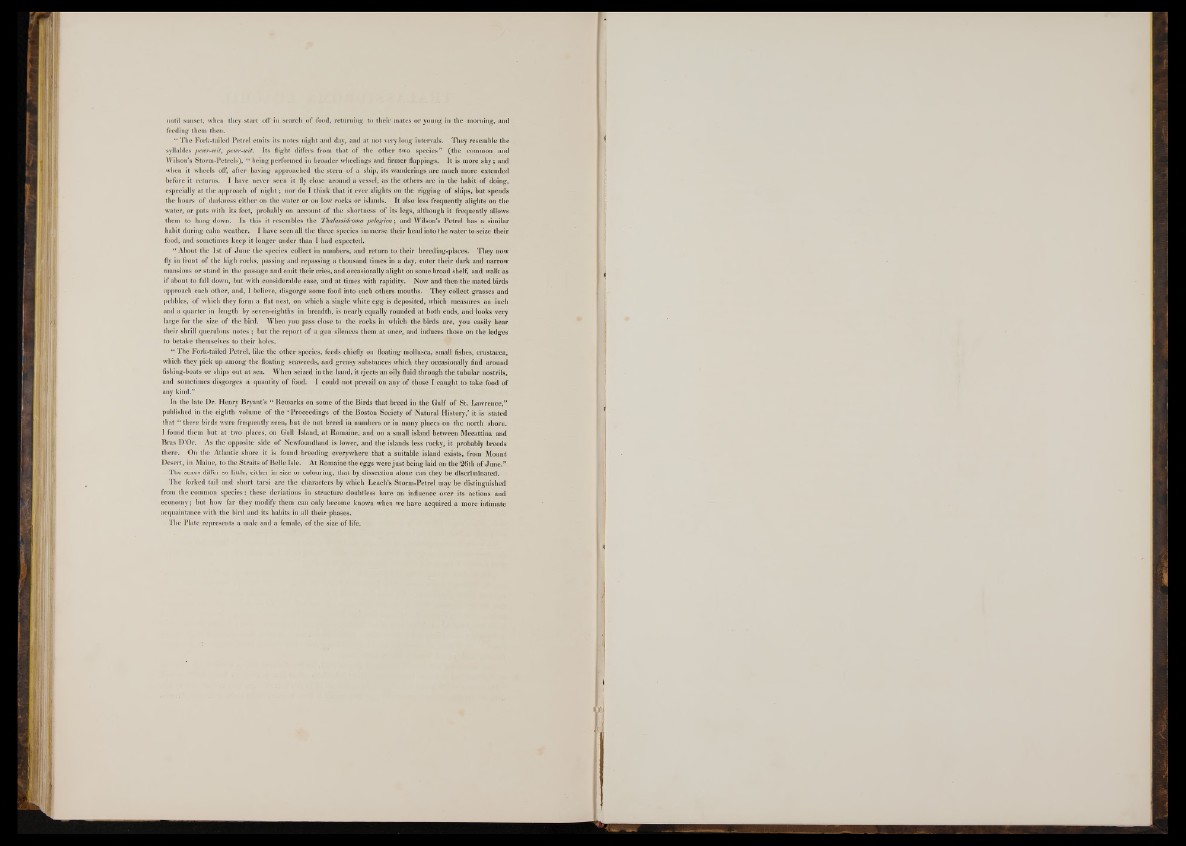
until sunset, when they start olf in search of food, returning to their mates or young1 in the morning, and
feeding them then.
“ The Fork-tailed Petrel emits its notes night and day, and at not very long intervals. They resemble the
syllables peior-wit, pewr-wit. Its flight differs from that o f the other two species ” (the common and
Wilson’s Storm-Petrels), “ being performed in broader wheelings and firmer flappings. It is more shy; and
when it wheels off, after having approached the stern of a ship, its wanderings are much more extended
before it returns. I have never seen it fly close around a vessel, as the others are in the habit of doing,
especially at the approach of night; nor do I think that it ever alights on the rigging o f ships, but spends
the hours o f darkness either on the water or on low rocks or islands. It also less frequently alights on the
water, or pats with its feet, probably on account o f the shortness of its legs, although it frequently allows
them to hang down. In this it resembles the Thalassidroma pelagica; and Wilson’s Petrel has a similar
habit during calm weather. 1 have seen all the three species immerse their head into the water to seize their
food, and sometimes keep it longer under than I had expected.
“ About the 1st of June the species collect in numbers, and return to their breeding-places. They now
fly in front o f the high rocks, passing and repassing a thousand times in a day, enter their dark and narrow
mansions or stand in the passage and emit their cries, and occasionally alight on some broad shelf, and walk as
if about to fall down, but with considerable ease, and at times with rapidity. Now and then the mated birds
approach each other, and, I believe, disgorge some food into each others mouths. They collect grasses and
pebbles, of which they form a flat nest, on which a single white egg is deposited, which measures an inch
and a quarter in length by seven-eighths in breadth, is nearly equally rounded at both ends, and looks very
large for the size o f the bird. When you pass close to the rocks in which the birds are, you easily hear
their shrill querulous notes ; but the report o f a gun silences them at once, and induces those on the ledges
to betake themselves to their holes.
“ The Fork-tailed Petrel, like the other species, feeds chiefly 011 floating mollusca, small fishes, crustacea,
which they pick up among the floating seaweeds, and greasy substances which they occasionally find around
fishing-boats or ships out at sea. When seized in the hand, it ejects an oily fluid through the tubular nostrils,
and sometimes disgorges a quantity of food. I could not prevail on auy o f those I caught to take food of
any kind.”
In the late Dr. Henry Bryant’s “ Remarks on some of the Birds that breed in the Gulf o f St. Lawrence,”
published in the eighth volume o f the ‘ Proceedings o f the Boston Society of Natural History,’ it is stated
that “ these birds were frequently seen, but do not breed in numbers or in many places 011 the north shore.
I found them but at two places, on Gull Island, at Romaine, and on a small island between Mecattina and
Bras D’Or. As the opposite side o f Newfoundland is lower, and the islands less rocky, it probably breeds
there. On the Atlantic shore it is found breeding everywhere that a suitable island exists, from Mount
Desert, in Maine, to the Straits o f Belle Isle. At Romaine the eggs were just being laid on the 26th o f June.’’
The sexes differ so little, either in size or colouring, that by dissection alone can they be discriminated.
The forked tail and short tarsi are the characters by which Leach’s Storm-Petrel may be distinguished
from the common species: these deviations in structure doubtless have an influence over its actions and
economy; but how far they modify them can only become known when we have acquired a more intimate
acquaintance with the bird and its habits in all their phases.
The Plate represents a male and a female, of the size o f life.